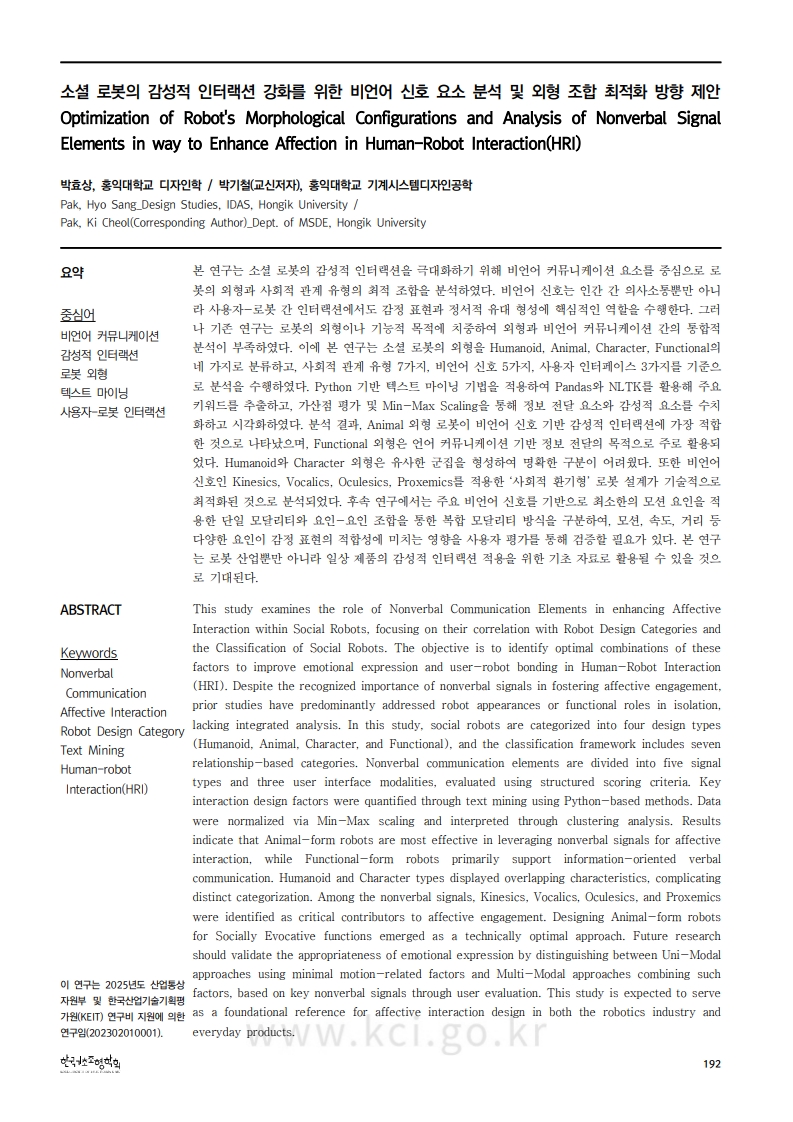통합 검색
통합 검색
- 작성자 hide
- 조회수 153

Topic: Optimization of Robot’s Morphological Configurations and Analysis of Nonverbal Signal Elements in a Way to Enhance Affection in Human–Robot Interaction (HRI)
The research collected case data on 40 social robots released between 2014 and 2024 and applied text mining and natural language processing (NLP) techniques (using NLTK and Pandas) to extract key features. The data underwent tokenization, stop-word removal, and lemmatization, followed by One-Hot Encoding and Min-Max Scaling to enable quantitative analysis through scatterplot and clustering techniques. Based on these analyses, the study hypothesized and verified that verbal communication primarily serves informational purposes, whereas nonverbal communication is more strongly associated with emotional interaction.
The analysis revealed that animal-type robots were the most effective in eliciting emotional engagement through nonverbal signals such as gestures, facial expressions, eye contact, and spatial proximity. In contrast, functional-type robots relied heavily on linguistic cues and GUI-based interfaces for information delivery. Humanoid and character-type robots exhibited hybrid communication characteristics, making their boundaries less distinct; clustering analysis confirmed their overlapping tendencies.
Regarding social relationship types, the “socially evocative” model—where the robot is perceived as an object of empathy and care—was found to contribute most significantly to emotional interaction. The key nonverbal signals supporting this relationship were kinesics, vocalics, oculesics, and proxemics. Notably, applying these cues to animal-type robots greatly enhanced emotional immersion, aligning with prior findings that the integration of form and behavior increases user intimacy and social acceptance.
In conclusion, the study identifies the combination of animal-like appearance, nonverbal communication cues, and socially evocative relationship type as the optimal configuration for maximizing emotional interaction in social robot design. However, the research acknowledges limitations, including the lack of real-world user experiments, the constraints of text-mining-based quantitative methods, and the ambiguity in distinguishing between humanoid and character forms. Future studies should incorporate user evaluations in real contexts, qualitative feedback, clearer morphological classification, and optimization strategies for nonverbal signaling. In particular, comparative validation between unimodal expression systems (minimal motion, high naturalness) and multimodal systems (combined affective cues) is recommended.
In summary, this study empirically demonstrates that the interaction between nonverbal cues and robot appearance critically determines the emotional quality of human–robot relationships. It positions animal-form robots and socially evocative relationship models as central strategies for future emotional robot design, offering foundational insights applicable not only to the robotics industry but also to the emotional interaction design of everyday products.
주제: 소셜 로봇의 감성적 인터랙션 강화를 위한 비언어 신호 요소 분석 및 외형 조합 최적화 방향 제안
본 연구는 소셜 로봇의 감성적 인터랙션을 강화하기 위해 비언어 커뮤니케이션 요소와 로봇 외형 간의 최적 조합을 분석하고, 사용자-로봇 관계에서 정서적 유대감을 높이는 방향을 제안하고 있다. 연구는 기존에 로봇의 기능적 목적이나 외형에만 초점을 맞춘 한계를 지적하며, 외형, 사회적 관계 유형, 비언어 신호를 통합적으로 검토했다. 로봇의 외형은 휴머노이드, 애니멀, 캐릭터, 펑셔널 네 가지로 분류하였고, 사회적 관계 유형은 총 일곱 가지, 비언어 신호는 Kinesics, Vocalics, Oculesics, Proxemics, Haptics 등 다섯 가지로 정의하였다. 또한 사용자 인터페이스 유형을 오디오, 그래픽, 내추럴 UI로 구분해 분석하였다.
연구 방법은 2014년부터 2024년까지 출시된 소셜 로봇 40종을 대상으로 사례 데이터를 수집하고, 텍스트마이닝과 자연어 처리 기법(NLTK, Pandas)을 활용하여 주요 키워드를 도출하였다. 데이터는 토큰화, 불용어 제거, 표제어 추출 등의 과정을 거쳐 정리되었고, 이후 One-Hot Encoding과 Min-Max Scaling으로 정량화하여 산포도와 클러스터링 분석을 진행하였다. 이를 통해 언어적 커뮤니케이션은 정보 전달 목적과, 비언어 커뮤니케이션은 감성적 인터랙션 목적과 강하게 연결됨을 가설로 설정하고 검증하였다.
분석 결과, 애니멀 외형 로봇이 제스처, 표정, 눈 맞춤, 거리 조절 등 비언어 신호를 활용해 감성적 교감을 이끌어내는 데 가장 적합한 것으로 나타났다. 반면 펑셔널 외형은 주로 음성 명령, GUI 기반 정보 전달에 초점을 두어 언어적 커뮤니케이션에 강하게 의존하는 특성을 보였다. 휴머노이드와 캐릭터 외형은 언어와 비언어 신호가 혼합적으로 나타나 명확한 경계를 구분하기 어려웠고, 클러스터링 분석에서도 동일한 집단에 속하는 경향을 보였다. 사회적 관계 유형 분석에서는 돌봄과 보살핌의 대상으로 인식되는 ‘사회적 환기형(Socially Evocative)’이 감성적 인터랙션 강화에 가장 큰 기여를 하는 것으로 확인되었다. 이때 핵심 비언어 신호는 Kinesics, Vocalics, Oculesics, Proxemics였으며, 특히 동물형 로봇에 이러한 신호를 적용할 경우 정서적 몰입도가 크게 향상되었다. 이는 기존 연구에서 제안된 “외형과 행동의 결합이 사용자 친밀감과 사회적 수용성을 높인다”는 결과와도 일치한다.
연구의 결론은 소셜 로봇 설계 시 애니멀 외형과 비언어 신호, 그리고 사회적 환기형 관계 유형의 조합이 감성적 인터랙션을 극대화하는 최적의 방향이라는 점이다. 그러나 연구는 실제 사용자 환경에서의 실험 부족, 텍스트마이닝 중심의 정량적 분석 한계, 휴머노이드와 캐릭터 외형 구분의 모호성 등 한계를 지닌다. 따라서 후속 연구에서는 실제 환경에서의 사용자 평가, 정성적 피드백 보강, 외형 분류 기준의 명확화, 비언어 신호 최적화 전략 마련 등이 필요하다. 특히 최소한의 모션으로도 자연스러운 감정 표현을 유지하는 단일 모달리티 방식과, 다양한 요인을 결합한 복합 모달리티 방식의 효과성을 비교 검증할 필요가 있다고 제안하였다.
요약하면, 본 연구는 비언어 신호와 로봇 외형의 상호작용이 사용자-로봇 관계의 감성적 품질을 좌우한다는 점을 실증적으로 보여주었으며, 애니멀 외형 로봇과 사회적 환기형 모델이 향후 감성적 로봇 설계의 핵심 전략임을 제시하였다. 이는 로봇 산업뿐 아니라 일상 제품의 감성적 인터랙션 설계에도 기초 자료로 활용될 수 있다는 점에서 의의가 있다.

댓글 0